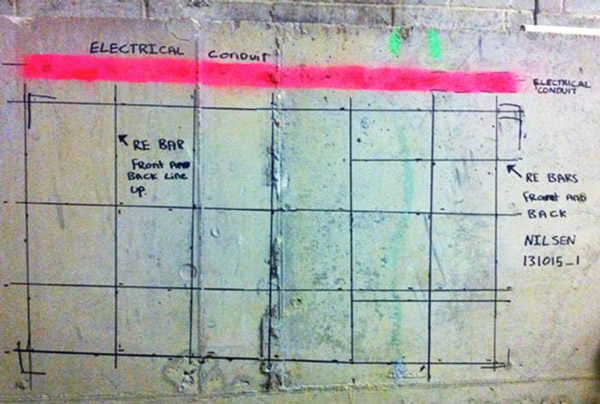Checking Out the Secret Benefits of Concrete Scanning in Building Projects
In the realm of modern-day building practices, the usage of concrete scanning technology has actually emerged as a pivotal device for ensuring job performance and architectural integrity. From boosting safety actions to accurately detecting energies concealed beneath the surface area, the advantages of concrete scanning are complex. The ability to simplify task timelines and minimize prices while protecting existing frameworks is a testament to the value this modern technology brings to the building and construction industry. As we look into the nuanced benefits of concrete scanning, it ends up being evident that its impact prolongs much beyond surface-level evaluations, using a glimpse into the elaborate internet of benefits waiting to be uncovered.
Improved Security Procedures
Using sophisticated concrete scanning modern technology boosts precaution on construction websites by giving accurate discovery of potential risks hidden beneath the surface area. This modern technology makes it possible for building and construction groups to determine rebar, conduits, post-tension cables, and various other obstructions before excavation or drilling, significantly lowering the danger of mishaps. By pinpointing these components precisely, employees can prevent damaging crucial structural parts, therefore avoiding injuries, delays, and pricey fixings.
Additionally, concrete scanning plays an important duty in making sure the integrity of existing frameworks throughout developments or remodellings. By spotting weak points, spaces, or wear and tear within concrete components, engineers can resolve these problems proactively, enhancing the general safety and security and long life of the building. This aggressive method not just reduces the threat of structural failings but additionally minimizes the capacity for crashes triggered by unpredicted structural shortages.
Basically, the application of concrete scanning technology serves as an aggressive safety step that safeguards both construction workers and the architectural integrity of buildings, eventually adding to the overall success and effectiveness of building and construction jobs. - RainierGPR Concrete Scanning
Accurate Discovery of Energies
Concrete scanning modern technology helps with specific recognition of underground utilities, improving building and construction website safety and efficiency. Precise discovery of utilities is important in building and construction tasks to prevent costly damages, project hold-ups, and most notably, make certain the safety of workers and the public. By utilizing advanced scanning innovations such as ground-penetrating radar (GPR) and electromagnetic induction, construction groups can draw up the area of hidden pipelines, cords, and various other energies with high levels of accuracy.

Time and Cost Efficiency

Concrete scanning modern technology enables building teams to properly situate rebar, post-tension cable televisions, and other ingrained things within concrete frameworks. This precise information aids in avoiding costly errors such as unintentional damage to essential elements during drilling, cutting, or coring tasks. In addition, by recognizing possible hazards beforehand, the need for expensive repair work or rework because of problems can be lessened, causing set you back financial savings for the job.
Additionally, the capacity to quickly and properly detect energies underneath the surface area without triggering any kind of damages not only saves time but likewise avoids pricey interruptions to existing facilities. In general, the time and cost performance advantages of concrete scanning make it an important tool for boosting find building and construction job management and execution.
Conservation of Architectural Integrity
Preserving the architectural honesty of buildings and infrastructure is paramount in making certain lasting stability and security. Concrete scanning plays a vital role in this preservation procedure by allowing building and construction experts to determine potential dangers to the architectural integrity of a structure or facilities prior to they intensify into significant issues. Via the usage of sophisticated scanning innovations such as ground-penetrating radar (GPR) and electromagnetic induction, building and construction groups can non-invasively assess the problem of concrete structures, find rebar, post-tension cables, and other ingrained components, and determine any spaces, cracks, or damage within the concrete.
Improved Project Preparation
In order to guarantee the successful execution of building and construction tasks, careful interest to detail and comprehensive planning are vital components that stem from a comprehensive understanding of the architectural problems identified through concrete scanning. Inevitably, integrating concrete scanning into the project preparation phase enhances control among team participants, fosters aggressive analytic, and adds to the click for more info successful distribution of building projects within spending plan and schedule restraints.
Final Thought
Finally, concrete scanning offers countless advantages in building and construction jobs. By boosting security measures, precisely spotting energies, improving time and price effectiveness, maintaining structural honesty, and aiding in job planning, concrete scanning verifies to be a vital tool for effective project implementation. Its ability to alleviate threats, enhance performance, and ensure job integrity makes it an indispensable possession for building and construction professionals.
In the realm of modern-day construction methods, the application of concrete scanning technology has arised as a critical device for making certain project effectiveness and architectural integrity.Concrete scanning innovation allows construction teams to properly find rebar, post-tension wires, and various other embedded things within concrete structures. With the use of advanced scanning innovations such as ground-penetrating radar (GPR) and electro-magnetic induction, building and construction groups can non-invasively assess the condition of concrete structures, situate rebar, post-tension cables, and other embedded elements, and identify any voids, cracks, or degeneration within the concrete.
In order to make certain the successful execution of construction projects, precise interest to detail and complete preparation are necessary elements that stem from an extensive understanding of the structural conditions determined via concrete scanning. Ultimately, incorporating concrete scanning right into the task preparation phase boosts coordination amongst team members, fosters aggressive analytic, and contributes to the effective delivery of construction projects within spending plan and routine restrictions.